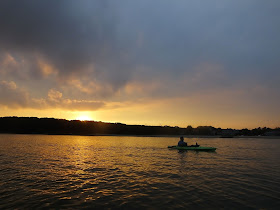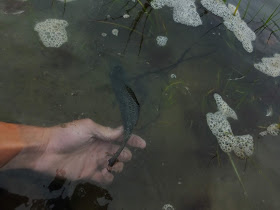Yesterday Noah and I went hunting for some of these fish. It was cloudy, muggy, and almost dead calm. I wasn't ruling out the potential for big stripers, or bluefish, as the area we were fishing has a tendency to hold them both even when other close-by locales don't. Schoolies and small cocktail blues were virtually assured.
We started out by cruising the very outside edge of a big flat. The fish I was expecting to encounter there is also one of my favorite alternative summer targets: sea robins. Outside of sight casting on the flats, they aren't particularly fun for an experienced angler. But they really don't deserve their reputation, nor to be called ugly.
I think they are adorable. But most who encounter sea robins don't do so on the flats. Having them follow me around like puppies, and take clousers presented literally on my foot very quickly got them a place in my heart.
Yeah, they are easy to fool, but any sight fishing opportunity presented should be taken as it provides some of the most significant insights into fish behavior, and no matter how daft you target is there is no better alternative than practicing dropping a fly the correct distance and angle in front of a living fish. This evening was odd. I saw numerous sea robins roll at the surface and bust on silversides but on the initial pass of the flat I didn't see even one in the water. I did, however, catch a bass.
The next move was to work a rip where massive amounts of silversides and bay anchovies congregate, as well as typical Northeast species like blues, albies, and bonito. Odd fish show up there too though, and that is our reason for fishing it. Spanish mackerel, jacks, ladyfish, triggerfish... nothing is really a surprise there. Today oddballs were lacking. So were bluefish, but they were around. A handful of bergalls, a scup, and a blue... now I was building a species list. The bergall photographed was from a different outing, but fits the size of the three I got today. When you're hoping for a banded rudderfish photographing a cunner is not a priority. Porgies are virtually everywhere in the Sound, and they are a really good alternative target for fly rodders in the summer. Fishing porgies on the fly often means long light leaders and heavy, heavy flies. I often circumnavigate the system and use either a fly tied on a jig or a drop shot rig. If I can chuck and duck it with a fly rod without risking snapping it, I will use it for porgies and black seabass. Don't get stuck in convention, this method is no less fly fishing than Euro-nymphing methods.
Next, we fished a can and a rockpile. Small fish often congregate on cans, and they can be a hotbed of odd species. Unfortunately the one we visited today was not a producer, but it could be in as little as a week or two.
Neither do skates. But when one is very brightly colored and lets you roll right up over it's noggin, unless you are paying no attention to the things you should be you are probably going to see it. When I spotted an orange and pink diamond shape with spots plastered on the sand I knew exactly what I was seeing and new I wanted to catch that sucker. I knew staying in the kayak which was drifting quickly down flat as not a good option, so I ditched it. I followed the fish, dropping my clouser in its path, and eventually got it to take. While I hooked the fish and started the fight Noah wrangled my kayak. I then retrieved it and walked both the skate and my kayak up onto the sand bar for a quick photo shoot.
That was the highlight of the day for me. Skates on the fly are not common. This is my second, same species as the first: clearnose skate, Raja eglanteria.
It was followed by a brief burst of sea robin activity, in which both Noah and myself hooked and landed one, then a lull as darkness fell. My last fish of the day was another bass, Noah's was a near legal fluke. Our species count was exceptional.

















































